The major scale is your starting point to learning guitar theory.
It should be the first scale you learn because it is THE basis of chords and other types of scales. The major scale is actually the basis of Western music as we know it, and there are many other scales that derive from this scale.
But we'll concentrate on just the major scale on this page.
If you learn the major scale and its applications, you will be able to understand how chords are constructed (it’s not that complicated 🙂 ), know WHY your favorite songs sound the way they do, play great arpeggios, and be able to write your own songs.
And all this from one scale, not bad!
Before we start, please make sure you understand the concept of notes in music and on the guitar.

Now, let’s begin.
What is a musical scale?
A scale is nothing more, than a group of 7 notes, each at a given distance of intervals apart, sounding in harmony when played together.
What are intervals on the guitar?
An interval is the distance between 2 notes on a scale, eg. the difference in pitch between 2 sounds. They are basically the building blocks of scales and chords.
Why are intervals important?
Read on.
Major Scale Guitar Basics
Before we continue, there are a few things you need to understand:
- The major scale (or any other scale) can root from any note. This is called the KEY of the scale.
- Scales are defined based on the intervals between the individual notes of the scale. In our example here, the major scale
- So when you hear the terms "A major scale" or "G major scale", you know the Key (root note) of the scale, and play the intervals from that given root note.
This sounds fuzzy at first, so let's have a look at the intervals of the major scale:
1 W 2 W 3 H 4 W 5 W 6 W 7 H 1
W = whole step (or 2 fret interval)
H = half step (or 1 fret interval)
And below is a simple example of the E major scale as defined by the intervals of the major scale:
Understand that:
- Since the root is on the E note (open low E string), this is an E major scale.
- Once we return to the root at fret 12, the E note one octave higher than the open E, the scale would start over again.
Scales can be viewed as a cycle. A never ending cycle actually.
But using just one string to play the scale is not really realistic.
We can transfer the individual notes to higher-pitched strings, moving along the intervals of the scale. You should already know the relation of strings, but just as a reminder, a single octave of the E major scale would look like this.
These are the exact same notes as the diagram above, but we moved them to different strings.
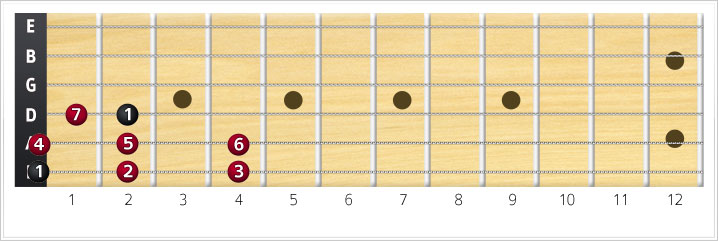
Other Major Scale Keys
If you'll remember, a scale can root from any note. The note will define the scale's key.
There are 12 notes in the musical alphabet, thus there are 12 major scale key altogether:
A, A#, B, C, C#, D, D#, E, F, F#, G, G#.
Some of these keys are used more often than others in popular music though. This has to do with the layout of the guitar fretboard, open chord positions, the ease of remembering notes in a given key, and the voice of artists. Anyhow, the most common keys are:
A, C, D, E, G
In our original example we had a look at the notes of the E major scale.
This time, let's have a look at the G major scale (aka key of G major).
The key of the scale is G, and our root note is at fret 3 of the low E string, which is a G note.
As you can see, once we reach the root G note one octave higher at fret 5 of string D, we start the scale over again, with the same intervals.
Now let's move the scale to the key of A, this is the A major scale:
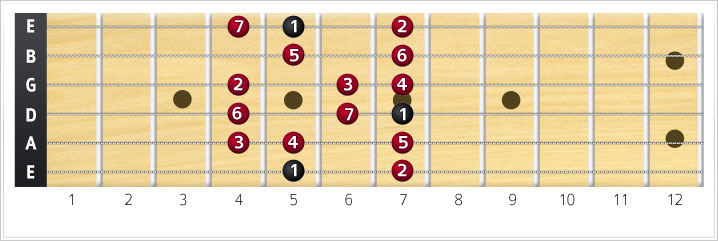
All we did was move the notes to root at A, to get the A major scale.
And along the same lines, you can move the above pattern to anywhere on the fretboard, and be in the major scale key of the root note.
The 5 Major Scale Patterns
Now we'll progress to seeing the major scale on the entire fretboard.
Let's stick with the A major scale to keep things focused.
Here are all of the notes of the A major scale on the fretboard (till the 12th fret).
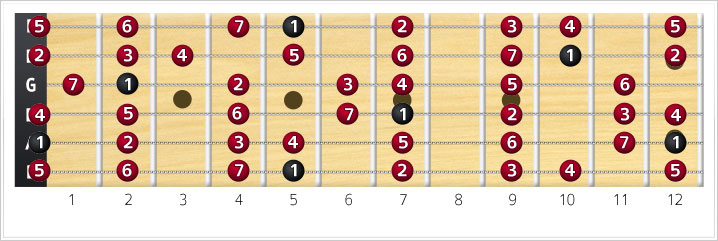
To help understand the above, remember that:
- The black 1 dots are the root notes of the A major scale, so all of the A notes on the fretboard.
- The rest of the dots and corresponding numbers are the notes of the major scale, as defined by the scale's intervals: whole - whole - half - whole - whole - whole - half.
The above barrage of notes is a whoozy, but we can simplify it using visual scale patterns.
And again, let's use a new key.
We'll use the C major scale below, so the key is C, meaning it roots off of the C note.
Yes, the first time I saw that, I said WOW as well.
It seems like a big mess at first, but it’s not.
The above diagram is meant to show you the interconnectivity of the major scale across the fretboard.
- First, notice that since we're the scale of C, all of the gray dots are on C notes.
- The red notes are the other notes in the scale, a given number of intervals apart, as specified by the major scale.
- Now have a look at the individual visual patterns, termed pattern 1 through 5. Those are the 5 major scale patterns.
- The patterns overlap!
The beginning of one pattern is the end of another, and vice-versa. - If you look at the pattern of intervals horizontally across any given string, they will all exhibit the same major scale pattern of intervals.
Connected the universe is, my young padawans :-)! - If you learn the individual scale shapes (I'll slice them out below), with the positions of the given shape’s root note, you’ll be able to root your major scale on any string, at any fret.
- These patterns repeat from fret 12, so the red dots across fret 12 are actually already a repetition of the red dots at fret 0 (open string), fret 13 would have the same notes as fret 1, and so on…
To make things a bit easier on your eyes, here are the individual major scale shapes in order, still in the C major scale:
Major Scale Pattern 1
Here is the 1st major scale pattern, we're using the key of C here for the example below.
Notice that it spans 4 frets, so it is easy to play and reach each fret of the pattern.
Major Scale Pattern 2
This is the 2nd major scale pattern.
This one spans 5 frets, so it is not as easy to play, but it is easy to remember the pattern shape.
Major Scale Pattern 3
Here is the 3rd major scale pattern.
Notice that it spans 4 frets, so the notes are easy to reach.
Major Scale Pattern 4
This is the 4th major scale pattern, it spans 5 frets.
Major Scale Pattern 5
And the last major scale patter, the 5th one.
Notice how the end of this pattern is exactly the beginning of the 1st pattern. Is cycles to infinity (or at least the length of your guitar's fretboard.
Takeaways
If you read the above, you should have an understanding of the major scale, and how it is constructed.
This doesn't mean you'll have learnt all of its notes and patterns, that takes a lot of practice.
Your most important takeaways should be:
- The major scale uses 7 notes.
- The 1st note is the root note, also called the Key of the scale.
- The intervals between the notes are (whole step = 2 frets, half step = 1 fret):
1 W 2 W 3 H 4 W 5 W 6 W 7 H 1 - If you know the intervals of the major scale, you can move up/down the fretboard as you like within the scale in any key.
- The visual patterns of the major scale on the guitar neck will help remember how to play the scale

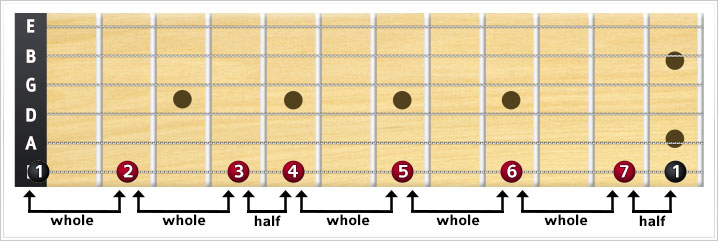
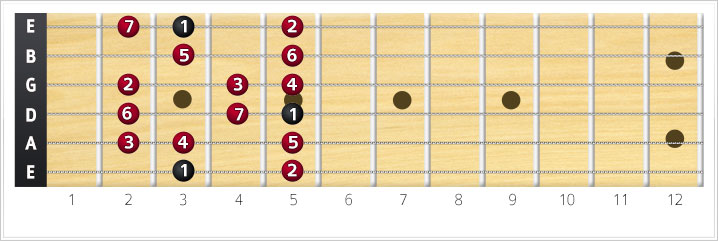
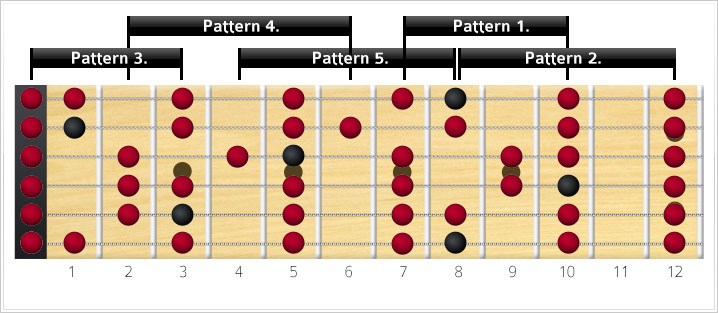
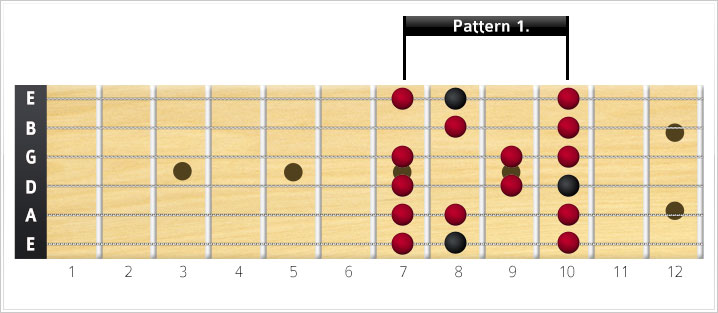
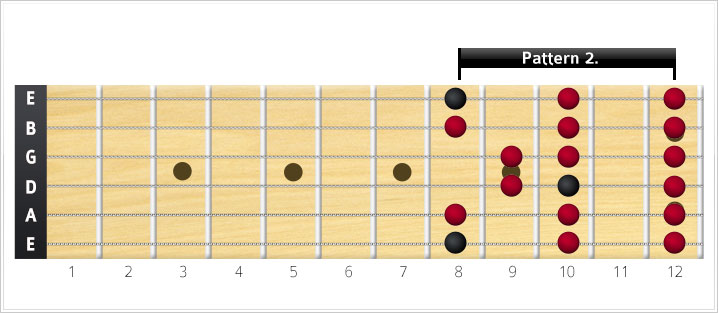
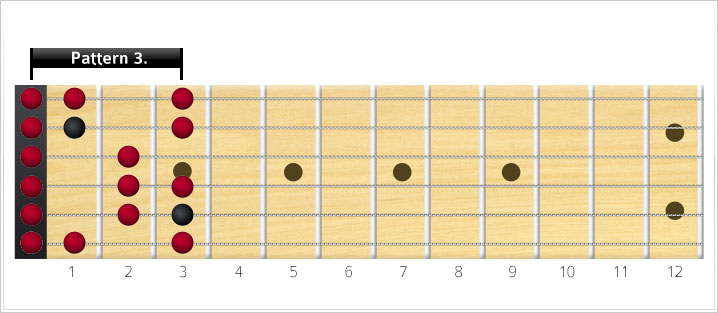
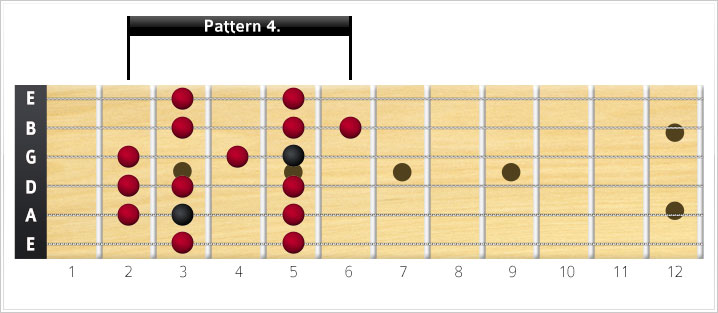
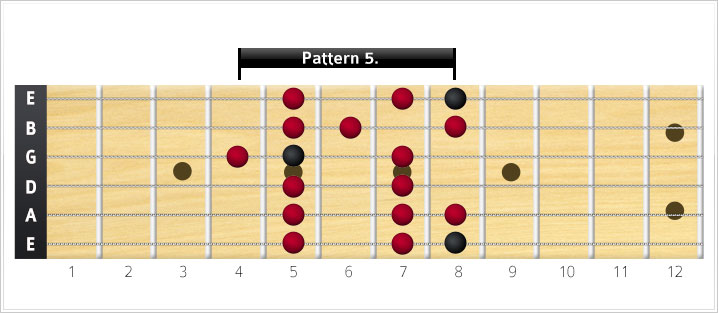




I decided to refresh my scale patterns as I haven’t visited them in years. I have zero idea what those 5 scales are showing hefre (I’m aware of all the patterns,forms, E A C etc.) but what’s shown makes no sense whatsoever.
Please read the information on the page, it explains everything.
Can you play position 1 starting on the A string?
Position 1 does not have the root note on the A string, if that is your question. But you don’t need to start a scale on the root not if you don’t want to.
I would say use Am for your piece. Play in C key, and yes each pattern can be moved along fret board HOWEVER remember steps and half steps CHANGE, go figure !
pattern 1 is wrong totally
the G major missing an f sharp on the second string
Hi, the separate image for pattern 1 is not a G major scale, it is a C major scale.
I added some text to make that more obvious.
Great lessons n for beginners, however i would suggest to actually play this…..first playing the first position in multiple.keys to get used to the pattern in different areas and unlocking different keys to then add the other positions and it helped me understand the scales and made the picture really clear….
Very informative and easy to understand if you try to figure out yourself and not just throwing a sudden questions.
using pattern three as an example, if the first note is the open E string which I understood to be the root note of the scale making it a E major scale why then do you say the root note of the pattern is C and by extension in the Key of C ?
The root note there is not E, it is C. The black dot marks the root note.
Think of intervals when you look at the scale shapes as well, not just the shape.
Tom,
Does Pattern 3 only work at the nut?
Hi, this pattern is in the key of C, so pattern 3 happens to fall to the nut. But all of these patterns are movable, based on which key you are in.
So for example, if you would use the key of D, you would move everything to the right by 2 semitones, so pattern 3 would start at fret 2.
Does that clear things up?
Question: The very first pattern mentioned above, before patterns 1-5, the one in the second picture which is the G major scale rooted on the low E string, is a movable scale, correct? You state that all major scales rooted on the low E have this shape. If that’s the case, why does the C major scale in pattern 2, which is also rooted on the low E string, have a different shape? I guess asked differently, why play 12th fret of low E and not stick to the original major pattern and play fret 7 on the A string (and then fret 7 on D instead of fret 12 on A, etc..)?
Hi, yes, these are movable shapes.
Pattern 1 and Pattern 2 are patterns meant to make remembering the position of notes in the scale easier.
You can see in the big pattern image, the one that includes all 5 patterns, that the patterns overlap.
You can choose where you want to play the given notes of the scale. It will depend on what is more convenient, nothing else.
If I understand, pattern 1 is the “movable” scale whereas the others are not.
All of the scale patterns are movable, not just pattern 1. That’s the advantage of learning a pattern. Learn it, and you can move it to whichever key you want to play it in.
Your pattern 2 on the g – 12 and b – 8 is the same note? Why is this?
Hi there, the word pattern might be misleading, as the notes are taken from the grand scheme of things, so all of the major scale notes on the fretboard. That section of the major scale does, indeed, have that repeating note. You should be mindful of this and use it to your advantage when choosing your fingering.
Each string has a relationship to each other.
Think about how you tune your guitar. Once you have your 6th string (thickest) correct you tune the string 5 open to string 6 fret 5. So there is a 5 fret difference between each neighbouring string EXCEPT string 2 which you tune to string 3 fret 4.
So therefore,
String 6 fret 8 and string 5 fret 3 are the same C (5 frets).
String 5 fret 7 and string 4 fret 2 are the same E (5 frets).
String 3 fret 12 and string 2 fret 8 and the same G (4 frets).
Hopefully this link will work. It will show you the relationship of each note on each string to all other strings.
https://www.reddit.com/r/guitarlessons/comments/cp7dg5/guitar_fretboard_octavesinrelationtopianooctaves/
wow.. it will helps me so much.. I am wondering about those intervals of the major scale.. you said said that the interval of major scale is 1 w 2 w 3 h 4 w 5 w 6 w 7 h 1 and it is nothing more than a group of 7 notes and it is true based on pattern 2, would please please help me whta would be the specific intervals of pattern 1, 3, 4 & 5?should I have to follow the interval pattern given to pattern 2 or there is other pattern of interval in pattern 1, 3 4 & 5? because I was confused sorry and.I hope you notice my comment.. I really wamt to learn thats why I read all of this from the beginning and I was feel grateful because I saw this website that will help me to le a rn about scales.. thank you so much and Godbless you always, from Philippines
To my understanding, the intervals are always the same for one given scale
Hi I’m very new to learning guitar and am really struggling with this, do yiu have any basic guidance to assist?
Where are the individual patterns, termed pattern I through V.
I have patter 3 down, but still struggling
Hi, this page shows the basic theory for reference, but it’s easier to learn from video lessons. Check out my beginner videos, there is one on scales.
Hi,
Can you please me understand Pattern 3 and 4 of the Major scale C mentioned above?
Over there can see only 2 Root notes i.e. C and in other, I can see 3 Root notes. So, how to end the scale in the root note i.e. C?
Hi, you need to move out of the box and use a C note from the next pattern.
In your example of the major scale, the root note is a C note. If you change the root note what changes in the scale, besides the root note; of course?
If you change the root of a scale, you need to move the entire set of positions over accordingly. So if you have a look at the second image on the page, you’ll notice that it is in the key of G, so the root is G, and the image shows the 1st major scale position.
It’s simply moved over. So in the key of C, this position would start at the 8th fret of the low E string, but since we’re rooting from G, we moved the entire scale shape over.
Best,
Tom